
According to the latest study by iData, the European Dental Materials market size is estimated to be at around €700 million in 2020. While the COVID19 pandemic had a major negative impact on the entire dental industry, the European market is expected to return to its pre-COVID numbers within the next two years and reach a valuation of €1.1 billion by 2026.
As the dental markets continue their recovery, the future of the Dental Materials market in Europe will be driven by the following trends:
- Dental cement market is leading the market growth
- Universal bonding agents to outperform the permanent cements market
- Aging population and cosmetic treatments are driving the EU market
- Resin-based cements are more preferred by the customers
- Over 50% of the market share continues to be dominated by 3M and GC Europe
1. Dental cement market is leading the market growth
Growth of the dental cement market stems from the shift towards permanent cements over temporary materials, which cost much less than permanent alternatives. While the temporary cement market is stagnant over the forecast period, the permanent cement market segment is expected to grow by almost 5% towards 2026. This indicates that the growth of permanent cements is being influenced by outside factors, such as technological developments.
2. Universal bonding agents to outperform the permanent cements market
Universal bonding agents are expected to surpass permanent cements in terms of growth. This is due to dentists moving away from total-etch to self-etch or universal systems, rather than a rapidly expanding market. As a result, this unsustainable growth is expected to taper off, whereas growth within dental cements is more reliable moving forward.
3. Aging population and cosmetic treatments are driving the EU market
The two main factors driving the dental market forward are the aging population requiring more crowns, bridges, and other restorations, as well as a push towards cosmetic dental treatment. The demand for tooth-colored restorations and minimally invasive treatments has increased tremendously in the past few years.New research indicates that these trends are expected to drive the demand for innovative and technologically advanced dental materials, resulting in higher average selling prices (ASPs) and market values.
4. Resin-based cements are more preferred by the customers
While a durable, long-lasting solution is the primary focus of restoration, patients are more focused on aesthetics. As customers continue to push for solutions that better a resemble natural tooth, resin-based cements are becoming more popular, as they offer options for shading, translucency, and coloring for a very close fit to a natural-looking tooth.
Outside of looking good, an ideal dental cement is non-irritant to dental tissues, provides a good seal, resistant to moisture, stress, temperature, and chemicals, possess a low film thickness, and form a long-lasting bond. Overall resin cements stack up well, as they are the least soluble, the best in terms of tensile and bond strength, and when used correctly rarely irate pulpal tissue.
However, the technique is key with this type of cement and the process is meticulous with a host of issues if done incorrectly. Improper technique can lead to bond strength decreasing greatly and a difficult clean-up.
5. Over 50% of the market share continues to be dominated by 3M and GC Europe
3M continued to be a market leader in the European Dental Materials market. The company led the competitive dental cement market segment, while targeting resin-based aesthetic solutions. Overall, the company competes on all platforms and is renowned to offer superior products. Headlining this company’s product portfolio is the RelyX™ resin family. This group includes two self-adhesive types of cement: the RelyX™ Unicem 2 Self-Adhesive Resin Cement and the original RelyX™ Unicem Self-Adhesive Resin.
Competing with 3M, GC Europe is expected to experience growth in the Dental Materials market with its composite resin products under the G-CEM™ family. G-CEM™ is a self-adhesive cement available in both a capsulated dose and an auto-mix syringe. As resin-based products and innovative delivery forms grow in demand throughout Europe, GC Europe and 3M are expected to maintain their market dominance. In 2020, these companies collectively accounted for more than 50% of the total European dental materials market.
European Dental Materials Market Forecast
Although each European country had a different response to COVID-19, the overall volume of dental treatments was lowered in an attempt to reduce the risk of COVID-19 transmission to dental professionals. While some countries continued to perform dental treatments, others completely shut down their clinics. Dental practices also took precautions to minimize aerosols and increase protection. Under the assumptions of the best-case scenario, the dental materials market will recover from the impact of COVID-19 by 2021, exceeding a market size of €1 billion.
Register to receive a free Dental Materials Market Report Suite for Europe 2020-2026 synopsis
The latest European research on the Dental Materials market demonstrates that digital integration is slowly occurring across European dental practices. The current barriers are high prices for CAD/CAM systems, and the steep learning curve for dentists adopting new systems into the workplace. However, once integrated, an intraoral scanner can streamline difficult dental procedures and improve efficiency in the dental offices.